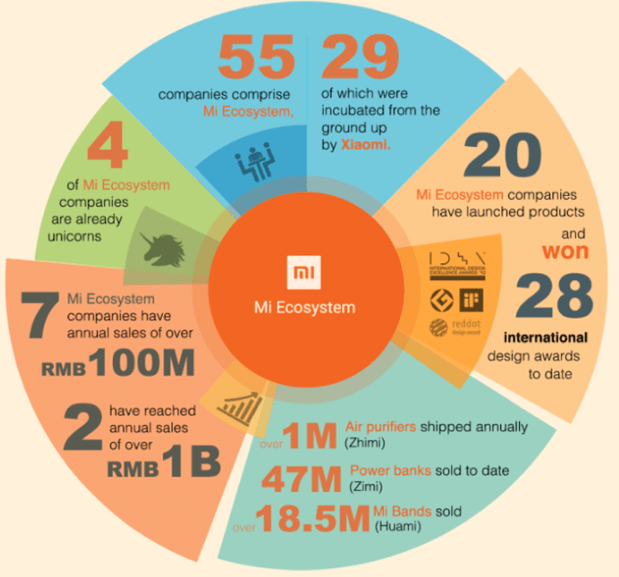Xiaomi Ecosystem: the core of business strategy
Xiaomi ecosystem is vast and comprises 55 companies including 29 companies that have been incubated from the beginning by Xiaomi. The company sells a wide range of products from smartphones to kettles and gloves. [1] Moreover, ever-expanding corporate ecosystem has been placed at the core of Xiaomi business strategy.
Usually, producing a wide range of products and services threats to compromise the focus on core products and services. However, Xiaomi claims to have addressed this threat in a proactive manner. Specifically, according to its official website, while the company focuses on its core products – smartphones, smart TVs and smart routers, Xiaomi invests in companies that produce other types of products without being involved in operational management.[2]

Xiaomi Ecosystem[3]
Smartphones are placed at the core of Xiaomi ecosystem. Moreover, smartphones are used to facilitate the sales and use of many other products and services. Xiaomi smart devices include Mi Water Purifier, Mi Air Purifier, Mi Induction Heating Rice cooker and other products.
All smart devices are connected to Xiaomi IoT platform and can be managed though Xiaomi smartphone. In 2013, the electronics and software company announced its plans to invest in 100 hardware startups.[4] The company also sells a range of “non-smart” products, like towels, and suitcases.
Increasing numbers of startups are currently joining Xiaomi ecosystem to gain support to grow rapidly. Xiaomi has experienced technical staff, engineers and product managers, who can play an instrumental role in fuelling the growth of small-sized companies.
At the same time, joining Xiaomi ecosystem also has some drawbacks. Specifically, start-ups need to operate with low profit margin according to Xiaomi business strategy. Moreover, over-dependence on Xiaomi for branding and distribution can be mentioned as another drawback of belonging to Xiaomi ecosystem.[5]
Xiaomi Inc. Report contains a full analysis of Xiaomi ecosystem. The report illustrates the application of the major analytical strategic frameworks in business studies such as SWOT, PESTEL, Porter’s Five Forces, Value Chain analysis, Ansoff Matrix and McKinsey 7S Model on Xiaomi. Moreover, the report contains analyses of Xiaomi leadership, business strategy, organizational structure and organizational culture. The report also comprises discussions of Xiaomi marketing strategy and addresses issues of corporate social responsibility.
[1] THREE XIAOMI PRODUCTS YOU NEED FOR A COZY WINTER (2017) Mi Blog, Available at: http://blog.mi.com/en/2017/11/27/three-xiaomi-products-you-need-for-a-cozy-winter/
[2] WE OFFER SMARTPHONES, AND TOOTHBRUSHES (2017) Mi Blog, Available at: http://blog.mi.com/en/2017/08/02/beyond-the-smartphone-why-we-make-consumer-products/
[3] Liao, R. (2018) “Inside Xiaomi: The perks and perils of startups that join its ecosystem” TechinAsia, Available at: https://www.techinasia.com/xiaomi-ecosystem
[4] Liao, R. (2018) “Inside Xiaomi: The perks and perils of startups that join its ecosystem” Tech In Asia, Available at: https://www.techinasia.com/xiaomi-ecosystem
[5] Liao, R. (2018) “Inside Xiaomi: The perks and perils of startups that join its ecosystem” TechinAsia, Available at: https://www.techinasia.com/xiaomi-ecosystem

